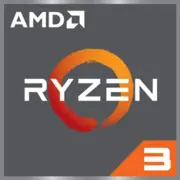AMD Ryzen 3 2200GE with Radeon Vega 8 Graphics

AMD Ryzen 3 2200GE with Radeon Vega 8 Graphics: A Budget Processor for Compact Systems
Current as of April 2025
Key Features: Architecture and Main Characteristics
The AMD Ryzen 3 2200GE processor, released in 2018, remains popular in budget builds due to its favorable combination of price and energy efficiency.
Architecture and Process Technology
- Zen (1st Generation): 4 cores and 4 threads without simultaneous multi-threading (SMT) support.
- 14 nm FinFET: An outdated process technology, but sufficient for basic tasks.
- Base Frequency: 3.2 GHz, Turbo — up to 3.6 GHz.
Integrated Graphics
- Radeon Vega 8: 8 compute units (512 streams), frequency up to 1100 MHz.
- Supports 4K output via HDMI 2.0 and DisplayPort.
Cache and TDP
- L3 cache — 4 MB.
- TDP — 35 W: Ideal for compact systems without active cooling.
Price in 2025: $60–80 (new, retail).
Compatible Motherboards: AM4 Socket and Features
The processor uses the AM4 socket, ensuring compatibility with many boards from different generations.
Recommended Chipsets:
- A320: Budget option ($50–70). Suitable for office PCs but does not support overclocking. Example: ASUS Prime A320M-K.
- B450 ($80–100): The best choice. Supports overclocking (for other processors), USB 3.1, M.2. Example: MSI B450 Tomahawk.
Important:
- Some boards require a BIOS update to work with the Ryzen 3 2200GE. Check the BIOS version before purchasing.
- For mini-PCs, Mini-ITX format boards are suitable, like the ASRock B450 Gaming-ITX/ac.
Supported Memory Types: DDR4 and Dual-Channel Mode
The processor works only with DDR4. DDR5 support is not available.
Recommendations:
- Frequency: Optimal — 2933–3200 MHz. Using 2400 MHz memory decreases Vega 8 performance by 15–20%.
- Dual-Channel Mode: Required! 2 modules of 8 GB (totaling 16 GB) provide +30% FPS in games compared to single-channel mode.
Example: A set of Crucial Ballistix DDR4-3200 16 GB (2x8) costs around $45.
Power Supplies: Minimum Requirements and Future Headroom
With a TDP of 35 W, the processor is very power-efficient.
Recommendations:
- For a system without a discrete graphics card: A 300–400 W PSU (for example, EVGA 400W, $35).
- For upgrade headroom: 500–600 W (Corsair CX550, $60).
Important: Even with Vega 8, do not skimp on the PSU — cheap models may become unstable under load.
Pros and Cons of Ryzen 3 2200GE
Pros:
- Low power consumption: Suitable for mini-PCs and home servers.
- Integrated graphics: Can run light games (CS:GO, Dota 2) at 30–50 FPS in HD.
- Price: One of the most affordable processors with Vega graphics.
Cons:
- 4 threads: Multitasking is limited (streaming + gaming = lag).
- No PCIe 4.0: Maximum storage speed is up to 3.5 GB/s.
- Outdated architecture: Falls behind modern Celerons in single-threaded tasks.
Usage Scenarios: Where the Processor Can Shine
1. Office Tasks: Document work, browser (20+ tabs), Zoom.
2. Multimedia: Watching 4K videos, Netflix streaming.
3. Light Gaming:
- Dota 2: 720p, medium settings — 60 FPS.
- GTA V: 1080p, low settings — 30–40 FPS.
4. Home Server: NAS based on Proxmox or TrueNAS.
Limitations: Not suitable for 4K video editing or modern AAA games (Cyberpunk 2077, Starfield).
Comparison with Competitors
AMD Ryzen 3 2200GE vs Intel Core i3-8100
- Performance: i3-8100 is slightly faster in single-threaded tasks (+10%).
- Graphics: Vega 8 outperforms UHD 630 by 40–50%.
- Price: i3-8100 costs $90–100, which is 20% more expensive.
VS Intel Pentium Gold G7400 (2025)
- Pros of Pentium: Newer (10 nm), supports DDR5.
- Cons: UHD 710 graphics are 30% weaker than Vega 8. Price — $75.
Conclusion: Ryzen 3 2200GE wins in the budget segment thanks to its graphics.
Practical Assembly Tips
1. Cooler: The stock cooler is sufficient, but for quiet operation, opt for the DeepCool Gammaxx 400 ($20).
2. Storage: An SSD is mandatory (for example, Kingston A400 480 GB, $30). An HDD will slow down the system.
3. Case: For mini-PCs — Cooler Master MasterBox Q300L.
4. BIOS: Update to the latest version for stability.
Example Build for $300:
- Processor: $70.
- Motherboard A320: $60.
- Memory 16 GB: $45.
- SSD 480 GB: $30.
- PSU 400W: $35.
- Case: $40.
Final Conclusion: Who is the Ryzen 3 2200GE Suitable For?
This processor is ideal for:
- Budget Office PCs: Cheap, reliable, sufficient for basic tasks.
- Home Media Centers: 4K video, streaming, light gaming.
- Compact Systems: Mini-PCs for work or study.
Why in 2025?
Despite its age, the Ryzen 3 2200GE remains a worthwhile option due to its low price and integrated graphics. However, for gaming or professional tasks, it's better to consider the Ryzen 5 5600G or Intel Core i3-12100.
This article is current as of April 2025. Prices are for new devices in retail stores in the USA.
Basic
CPU Specifications
Memory Specifications
GPU Specifications
Miscellaneous
Benchmarks
Compared to Other CPU
Share in social media
Or Link To Us
<a href="https://cputronic.com/en/cpu/amd-ryzen-3-2200ge-with-radeon-vega-8-graphics" target="_blank">AMD Ryzen 3 2200GE with Radeon Vega 8 Graphics</a>